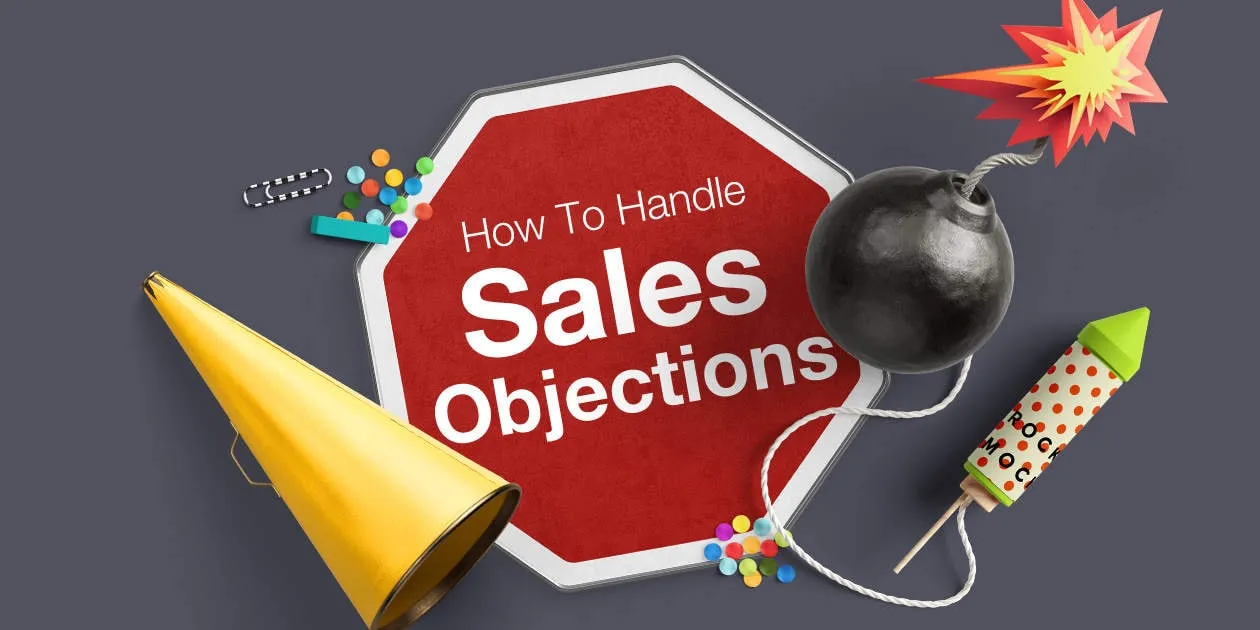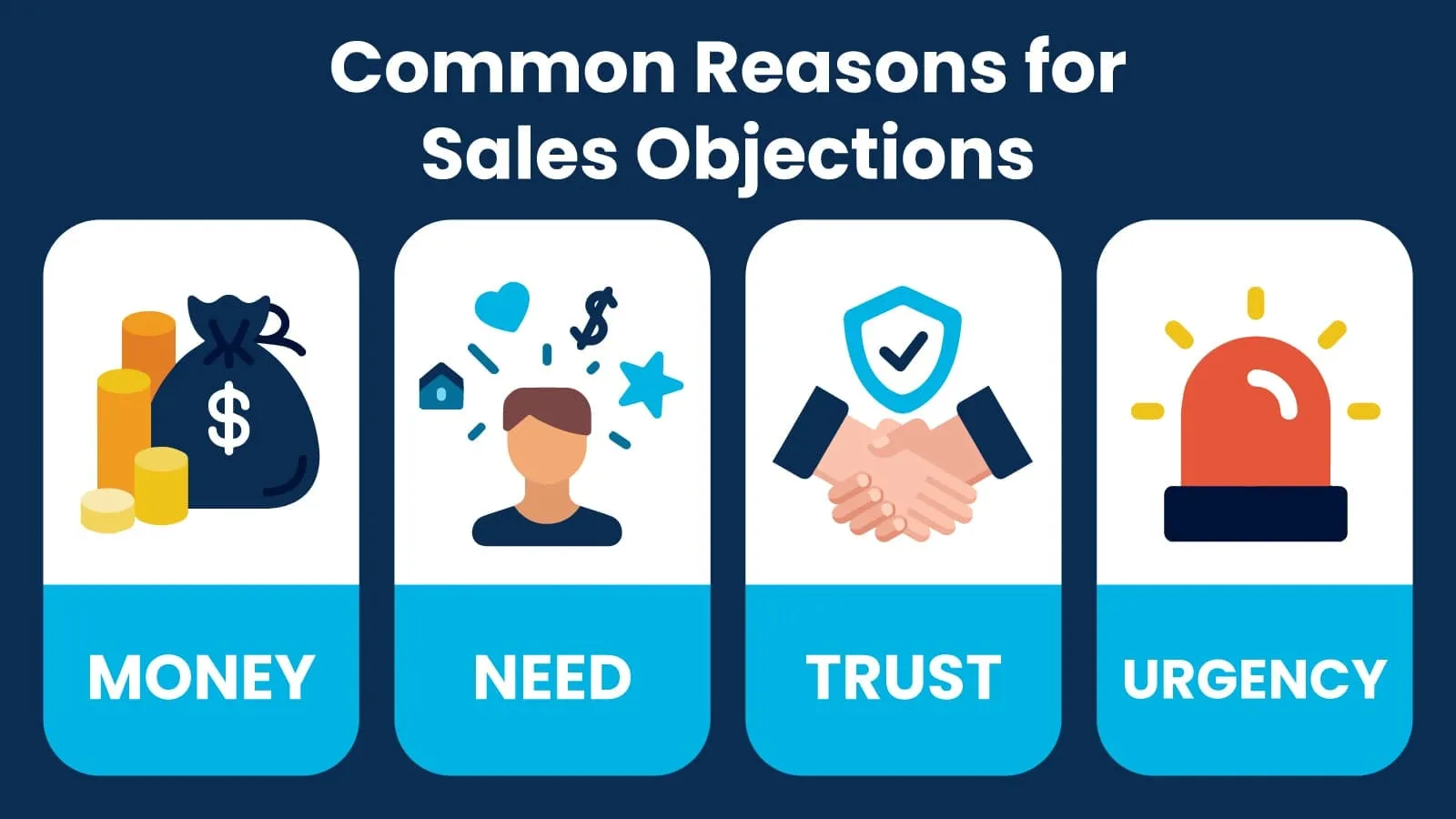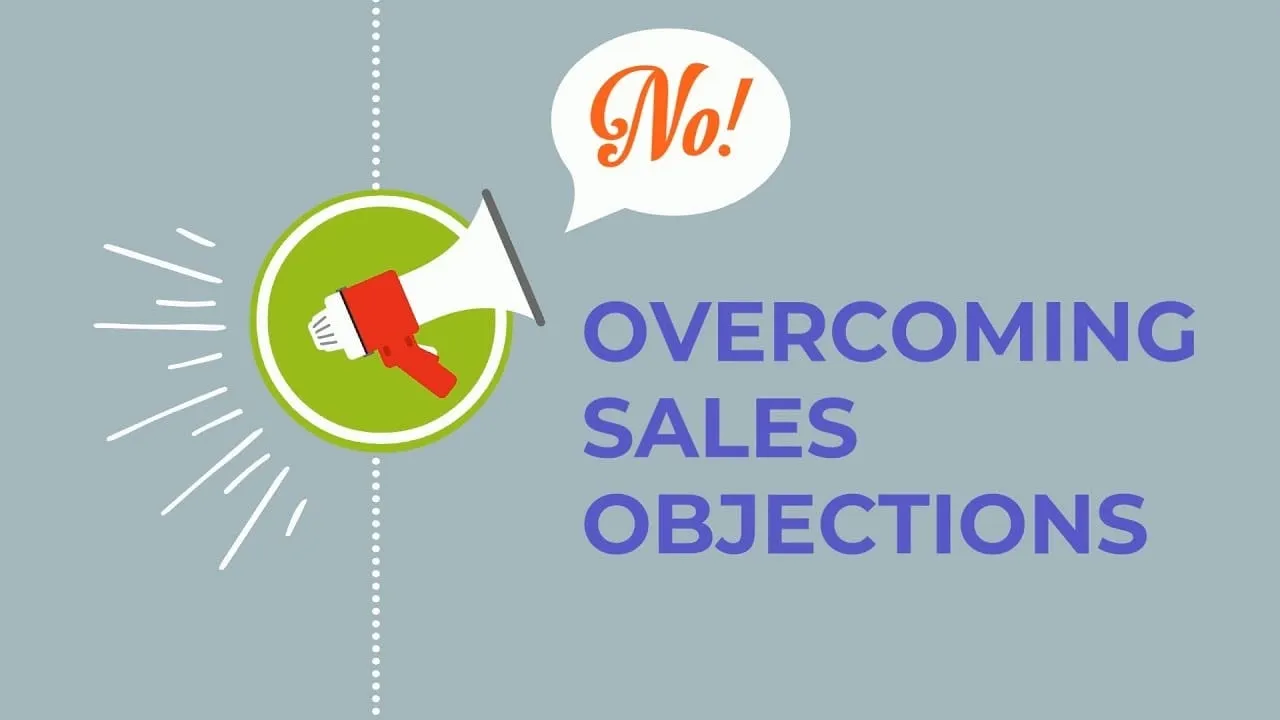Dealing with sales objections is a common challenge for every sales rep, but mastering objection handling can turn these challenges into opportunities. Whether it's addressing common sales objections or tackling price objections, understanding your prospect's concerns is key to building stronger relationships.
According to a HubSpot study, over 60% of potential customers hesitate to buy due to unclear value propositions or unresolved objections. By learning to anticipate objections and respond appropriately, sales teams can navigate the sales process with confidence.
This guide provides actionable tips to overcome objections, handle sales objections effectively, and close deals with increased efficiency.
What is a Sales Objection?

A sales objection occurs when a prospect raises concerns or doubts that hinder their decision to move forward with a product or service. These objections can stem from various pain points, such as budget allocation, lack of perceived value, or a mismatch with the prospect's needs. For sales reps, understanding these objections is a crucial part of the sales process.
Sales objections are not necessarily a rejection but an opportunity to address the prospect's concerns and build rapport. Common objections like “the price is too high” or “I need to consult the decision maker” are part of almost every sales cycle.
By addressing these challenges with active listening and a clear value proposition, sales teams can turn objections into chances to close deals.
What Does Objection Handling Mean?

Objection handling is the process of addressing concerns that prospects raise during the sales process. When a prospect expresses sales objections, whether about price, product features, or decision-making authority, it’s a sign they need more clarity. For sales reps, it’s essential to understand the underlying pain points and offer solutions that meet the prospect’s needs.
Effective objection handling involves active listening, asking the right questions, and responding confidently. By addressing concerns thoughtfully, you build trust and guide prospects closer to a purchase decision, turning objections into opportunities.
Why Sales Objection Handling is Crucial

1. Building Trust and Credibility with Customers
Handling sales objections builds trust. When a sales rep listens to common objections and responds thoughtfully, it shows the prospect they’re valued. Addressing concerns like price objections or contract terms builds credibility and sets a solid foundation for the sales process.
By addressing prospect's concerns, sales reps demonstrate expertise in specific industry and gain the prospect’s trust.
2. Turning Objections into Opportunities
Every sales objection is a chance to present a solution. Instead of avoiding objections like pain points or budget allocation, sales reps should use them to highlight the value proposition of the product.
By understanding and overcoming prospects' sales objections, sales reps can convert doubts into opportunities to close more deals and drive new revenue.
3. Improving Conversion Rates by Addressing Concerns
Addressing sales objections head-on boosts conversion rates. When a sales rep answers prospect's concerns, like pain points or product features, it reduces hesitation.
Responding to price objections or common sales objections early in the conversation helps prospects feel more comfortable, ultimately leading to higher conversion rates.
4. Creating a Positive Customer Experience
Effective objection handling creates a positive experience for the prospect. By listening to prospect problem areas and responding with solutions, sales reps show they care.
Whether addressing types of sales objections or providing social proof, helping prospects feel understood makes the entire process smoother and more enjoyable.
5. Enhancing Long-Term Client Relationships
When sales reps handle objections well, they strengthen client relationships. Showing that you understand the prospect’s pain points and can provide the right solutions fosters trust and loyalty.
This creates long-term relationships and keeps the door open for future sales, as the prospect knows the sales team is reliable and attentive.
6. Boosting Confidence and Effectiveness in Sales Conversations
Mastering objection handling boosts confidence. A sales rep who can handle sales objections like price objections or common sales objections effectively feels more capable in conversations.
This confidence helps shorten the sales cycle and makes closing deals smoother. By anticipating and responding to objections, reps improve their overall effectiveness.
By mastering the art of handling sales objections, sales reps can boost conversion rates, enhance customer experiences, and foster long-term relationships, all while improving their own confidence and effectiveness in the sales process.
Types of Sales Objections

1. Price Objections
Price objections are one of the most common sales objections. Prospects often feel the product or service is too expensive for their budget.
When facing this objection, it's important for sales reps to highlight the value proposition, showing how the benefits outweigh the costs.
Reps can also share social proof or emphasize the long-term value to address these concerns. Overcoming price objections helps in both building relationships of trust and moving the sales conversation forward.
2. Need-Based Objections
Need-based objections occur when the prospect doesn’t believe they need the product or service.
They might not see how it solves their pain points or aligns with their current goals. In these cases, sales reps should focus on identifying the prospect’s pain points and demonstrating how the product can resolve them.
By asking open-ended questions and truly listening to the prospect's needs, sales reps can reshape the conversation and make the solution more appealing.
3. Timing Objections
Timing objections happen when the prospect isn’t ready to make a purchase yet, either due to timing or other external factors.
They may say it’s not the right moment to buy, or they might be waiting for a different sales cycle to begin. In this case, sales reps can emphasize how delaying the purchase might lead to missed opportunities.
Offering a follow-up call or highlighting a sense of urgency can help overcome timing objections and move the sale forward.
4. Authority Objections
Authority objections arise when the prospect is not the decision-maker or lacks the authority to make the final purchase decision. They may need to consult with other decision makers or get approval from a superior.
Sales reps should identify the right person with decision-making authority and offer to include them in the conversation.
Understanding the sales process and asking the right qualifying questions can ensure you're speaking to the right person and increase your chances of closing the deal.
Each of these types of sales objections requires a different approach, but with the right tools and understanding, sales reps can handle objections more effectively and keep the conversation moving toward a successful close.
How to Overcome Sales Objections

Sales objections are a natural part of any sales cycle, and how you handle them can directly impact your conversion rates. Here’s a clear breakdown of how to overcome sales objections effectively:
1. Listen Actively and Understand the Objection
To overcome sales objections, the first thing you need to do is listen. This isn’t just about hearing the words the prospect says but understanding their pain points.
Active listening helps you identify the types of sales objections, whether they are related to price, product features, or something else.
When you listen closely, you can address their concerns more directly.
2. Acknowledge the Customer’s Concern with Empathy
Once you understand the objection, acknowledge it. This shows the prospect that you respect their concerns and aren’t just pushing your product.
Whether it’s a price objection or a pain point about product fit, showing empathy can help maintain rapport.
This also gives the sales rep a chance to build trust and defuse any initial resistance.
3. Ask Clarifying Questions to Dig Deeper
Sometimes, sales objections are surface-level issues. By asking clarifying questions, you can uncover the real concern behind the objection. Use open-ended questions to get the prospect talking.
For example, “What’s the biggest challenge you’re facing right now in this area?” This approach helps you understand their true needs, which you can later address with your solution.
When a prospect raises an objection, it's essential to understand the underlying issue. By asking open-ended questions, you can uncover the true reason behind their hesitation.
Prospect asks insightful questions that reveal their concerns, giving you the opportunity to address objections before they become roadblocks. By digging deeper, you ensure that you're addressing the real issue, which could help in providing a more tailored response.
4. Present a Tailored Solution to Address the Objection
Once you've understood the prospect’s objection, it’s time to present a solution that directly addresses their concerns.
Make sure to explain how your product or service aligns with their needs. This approach helps make the solution clear and relevant.
When responding to objections, ensure your answer "makes sense" to the prospect by explaining how your solution directly addresses their pain points. This clarity will help the prospect feel more confident in their decision.
5. Reframe the Objection in a Positive Light
Reframing objections is an effective strategy to turn a potential roadblock into a discussion point that reinforces the value of your offering.
For example, if a prospect raises an objection about the cost, you can reframe it by talking about the ROI or savings they will gain over time.
Reframing helps the prospect see the benefits from a new angle and moves the conversation forward.
6. Use Social Proof and Evidence to Build Trust
Using testimonials, reviews, and case studies from satisfied customers can significantly reduce objections.
In addition, leveraging social media platforms to share customer testimonials and case studies can effectively address common objections by providing social proof and building trust with prospects.
This real-world evidence reassures potential customers that others have found value in your product or service, making them more likely to overcome their doubts and move forward with the purchase.
7. Confirm the Customer’s Satisfaction and Move Forward
Finally, confirm that the prospect is satisfied with your solution and is ready to move forward.
Asking direct questions like, “Does this address your main concern?” ensures that any lingering doubts are resolved.
Once you’ve tackled their first objection, continue guiding them through the next steps in the sales process.
Effectively overcoming sales objections requires patience, empathy, and a structured approach. By actively listening, acknowledging concerns, and presenting a tailored solution, you can turn objections into opportunities.
Don’t forget to use social proof and reframe objections to build trust and move the conversation forward. By addressing common objections thoughtfully, you’ll enhance your sales calls and increase your chances of closing deals.
25 Most Common Sales Objections and How to Handle Them

Sales objections are a common part of the sales process. The key to overcoming them is to approach each objection with a clear understanding and a thoughtful solution. Below are 25 common sales objections you may encounter and how to handle them effectively.
1. “Your product is too expensive.”
This is a classic top objection. The prospect may believe the cost outweighs the value they’d get in return.
Solution: Reframe the conversation by emphasizing the long-term value and return on investment (ROI) your product offers. Explain how the benefits and savings over time justify the price.
2. “We don’t have the budget for this right now.”
When a prospect says they don't have the saved money, it often means they don’t see how your solution fits into their current financial plan.
Solution: Acknowledge their concern and offer to work within their budget. Demonstrate how your solution will save them money or create additional revenue, making it an investment rather than an expense.
3. “We’re already working with another vendor.”
This objection suggests that the prospect is satisfied with their current provider or is hesitant to switch.
Solution: Find out what they like about their current vendor. Then, show how your product can either complement or improve their existing solution. Offering a trial or demo can also help them experience the difference firsthand.
4. “I’m not the decision maker.”
If the person you're speaking with isn’t the final authority, they may hesitate to commit.
Solution: Politely ask to be introduced to the right decision maker. Offer to provide them with the necessary information to help facilitate the conversation and decision-making process.
5. “I don’t see the ROI.”
Prospects may not immediately see how your product will generate value or return on investment.
Solution: Provide clear examples of how your product delivers ROI, using case studies, testimonials, or data to back up your claims. Highlight specific benefits, such as increased efficiency or cost savings.
6. “We’re not ready to make a decision yet.”
This objection is often related to timing. The prospect might be interested but isn't prepared to commit right away.
Solution: Explore the reason behind their hesitation. Offer to take follow up questions at a later time or provide additional resources to help them make an informed decision. Sometimes, offering a limited-time promotion can help create urgency.
7. “We need more time to think it over.”
Sometimes prospects want to delay making a decision, even if they’re somewhat interested.
Solution: Offer to schedule a follow-up call or send additional materials to help them make up their mind. Reassure them that you’re available for any questions or concerns they might have during their decision-making process.
8. “Your product doesn’t meet our specific needs.”
The prospect may feel that your product doesn't solve their unique problems.
Solution: Ask questions to uncover their specific needs and show how your product can be tailored to fit their requirements. Offer solutions that align with their goals, and if necessary, demonstrate how your product's features can be adapted.
9. “We’re happy with our current solution.”
If a prospect is satisfied with their current solution, they may resist change.
Solution: Acknowledge their satisfaction and ask what they like most about their current solution. Then, highlight areas where your product may offer improvements or additional value, making it a worthy alternative.
10. “We don’t have the resources to implement this.”
The prospect may be concerned about the time, effort, or resources needed to adopt your solution.
Solution: Reassure them that the implementation process is simple and that you offer support throughout. Highlight how your product will save them time and resources in the long run, making it a worthwhile investment.
11. “I need to consult with my team first.”
This objection often means the decision isn’t in the hands of one person.
Solution: Offer to facilitate the discussion with the rest of the team by providing additional materials or answering any questions they may have. Scheduling a joint call with the team can also help speed up the process.
12. “We’ve tried something like this before, and it didn’t work.”
If a prospect has had a bad experience with a similar solution, they may be hesitant to try again.
Solution: Listen to their concerns and identify what went wrong. Explain how your solution is different, and offer proof (case studies or testimonials) to show how it has worked for other clients and businesses with similar challenges.
13. “We don’t see a need for this right now.”
Some prospects may not immediately recognize the need for your solution, especially if they’re not experiencing an obvious problem.
Solution: Highlight the potential long-term benefits of your product. Show how it can prevent future problems or improve efficiency, even if the need isn’t urgent at the moment.
14. “We’re just gathering information right now.”
Prospects may not be ready to make a decision but are interested in learning more.
Solution: Provide valuable information, including case studies, success stories, and product demonstrations. Offer to follow up after they've had time to review the information and assess their own business needs.
15. “Your contract terms are too rigid.”
Some prospects may feel that the terms of the agreement don’t offer enough flexibility.
Solution: Clarify the terms and see if there’s room for adjustment. If possible, offer flexible payment plans or tailor the terms to meet the prospect's needs.
16. “We’re too small for your product.”
Small businesses often feel that a solution is only for larger organizations.
Solution: Emphasize how your product is scalable and can grow with their business. Highlight how even small businesses benefit from the solution in terms of efficiency, cost savings, or growth opportunities.
17. “We don’t trust your company.”
If a prospect has concerns about your company’s reputation, it can hinder the sales process.
Solution: Use social proof by sharing testimonials, customer reviews, and case studies. Highlight your company's track record of success and emphasize your company commitment to customer satisfaction.
18. “Your product lacks certain features we need.”
If your product doesn’t have a feature the prospect needs, they may decide it’s not the right fit.
Solution: Explain how your existing features can still meet their needs. If the feature is on your roadmap, let them know and offer to update them when it becomes available.
19. “We’ve had a bad review about your company.”
A negative review can cause doubt in the prospect’s mind.
Solution: Address the review head-on, offering your perspective on the situation. Use social proof to show that the majority of customers are satisfied with your solution and how you’ve resolved any past issues.
20. “We don’t have the time to invest in this right now.”
Time constraints are a common concern, especially if the prospect feels overwhelmed.
Solution: Show how your solution saves time and simplifies tasks, making it easier for them in the long run.
Offer a brief demo or quick call to show how quickly they can implement the solution.
21. “We don’t need a solution like yours.”
Some prospects may not understand the need for your solution.
Solution: Ask questions to uncover their pain points and show how your product can address those challenges. Focus on the long-term benefits and potential improvements your solution offers.
22. “We are satisfied with our current supplier.”
Prospects who are happy with their existing supplier may resist switching.
Solution: Find out what they like about their current supplier and explain how your solution offers additional benefits, such as better features, customer support, or pricing.
23. “We don’t believe this will work for our business.”
Some prospects may be skeptical about how your product will work for them.
Solution: Share relevant case studies and examples of similar businesses that have had success with your solution. Provide clear, data-backed evidence of its effectiveness.
24. “We’re already looking at other options.”
When a prospect is exploring other options, they may be less inclined to commit to yours.
Solution: Ask what they’re considering and highlight how your product is different or superior. Focus on unique benefits and how your solution addresses their specific needs.
25. “This seems too complicated.”
If a prospect feels overwhelmed by your solution, they may hesitate to move forward.
Solution: Simplify the conversation and explain how easy it is to implement and use your product. Offer a demo or free trial to show how user-friendly your solution is.
Handling sales objections effectively is an important skill for any sales rep.
By addressing prospect’s concerns with clear, concise solutions, you can build trust, alleviate doubts, and move the sales process forward.
Keep the focus on the value your product brings, and don’t shy away from offering social proof and tailored solutions to overcome objections.
9 Tips to Handle Sales Objections

Handling sales objections effectively is crucial for closing deals and building long-term customer relationships. Here are 9 practical tips to help you navigate objections successfully:
1. Stay Calm and Composed Under Pressure
When a prospect raises an objection, staying calm helps you think more clearly and respond effectively. Take a deep breath and focus on maintaining a composed demeanor.
This will not only help you process the objection more efficiently but also convey confidence in your product, easing the prospect’s concerns.
2. Turn Objections into Conversations, Not Arguments
Objections are a natural part of the sales process, but they don’t have to lead to an argument.
Engage the prospect by asking open-ended questions to understand their concerns better.
This helps create a constructive conversation and shows the prospect that you’re genuinely interested in solving their problem, rather than just making a sale.
3. Focus on the Customer’s Needs, Not Just the Sale
The key to overcoming objections is aligning your solution with the customer’s needs, not just focusing on closing the deal.
Shift the focus from pushing for the sale to demonstrating how your product can directly address the customer’s pain points.
This approach builds trust and helps the customer feel understood, making them more likely to consider your solution.
4. Use the "Feel-Felt-Found" Method to Relate
Empathy can go a long way in handling objections effectively.
When you hear an objection, use the "Feel-Felt-Found" method: "I understand how you feel. Other customers have felt the same way, but what they found is that our product helped them solve [insert problem]."
This method helps prospects feel understood while guiding them toward seeing the value in your solution.
5. Keep Your Responses Concise and to the Point
Lengthy explanations can confuse prospects and weaken your message.
Address the objection in a clear, concise manner. Focus on the key benefits of your product or service that directly address the prospect’s concern.
A direct response keeps the conversation focused and reassures the prospect.
6. Maintain a Positive Attitude Throughout the Interaction
A positive attitude helps build rapport and trust with prospects, even when faced with objections. Negative or defensive responses can be "off putting" and can derail the conversation.
Instead, stay calm and composed, and focus on providing value. A positive demeanor allows the prospect to feel comfortable and more open to discussing their concerns.
7. Ask for Feedback After Overcoming an Objection
After addressing an objection, it’s crucial to check in with the prospect and ensure they’re satisfied with your response.
Ask if they have any further questions or concerns. Always be ready to "answer questions" that may arise, as this shows your commitment to providing clarity and value.
This step not only helps build trust but also keeps the conversation moving forward in a positive direction.
8. Practice Active Listening to Build Rapport
Active listening shows the prospect that you value their input and understand their needs.
Listen attentively, paraphrase their concerns, and respond with empathy. This builds trust and rapport, making it easier to handle objections and move the conversation forward in a positive direction.
9. Know When to Walk Away or Close the Deal
Not every prospect will be ready to close the deal immediately. Sometimes, it’s better to step back and give the prospect time to reconsider.
If the prospect indicates that they are not ready to go ahead, ask if they’d like to revisit the conversation "next quarter". If the prospect is continually stalling or hesitant, it may be a sign that continuing the conversation will only "waste time" for both parties.
This allows you to maintain the relationship while also giving the prospect time to align their budget or priorities, without feeling pressured.
By incorporating these 9 tips into your sales approach, you can handle sales objections more effectively and build stronger relationships with prospects.
Focusing on the customer’s needs, maintaining a positive attitude, and using proven methods like “Feel-Felt-Found” will help you navigate objections with confidence and increase your chances of closing the deal.
Conclusion
Mastering sales objection handling is a crucial skill for any sales professional. By understanding the common types of objections and using proven strategies like active listening, empathy, and the “Feel-Felt-Found” method, you can turn potential roadblocks into opportunities to build trust and close more deals.
Remember, most sales objections are a natural part of the process, and how you respond can make all the difference. Stay calm, focus on the customer’s needs, and use the tips shared in this guide to navigate objections confidently.
With practice, you’ll not only overcome objections but also enhance your overall sales performance, leading to more revenue, stronger relationships with your prospects and a more successful sales career. Keep refining your approach, and you'll see your efforts result in increased conversions and long-term customer loyalty.

.webp)



.jpg)

.jpg)
